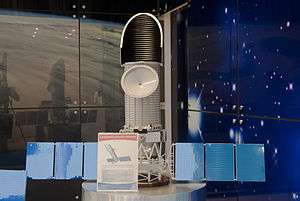Spektr-UV

The Spektr-UV, also known as World Space Observatory-Ultraviolet (WSO-UV), is a proposed space telescope intended for work in the 110 nm to 320 nm wavelength range. Launch had been planned for 2007 or earlier,[1] but the current launch date estimate is 2021.[2]
The observatory
The main instrument of the observatory is 1.7-metre Ritchey-Chretien telescope. The telescope will be equipped by the following instruments:
- HIRDES (High-Resolution Double Echelle Spectrograph): R~55000 spectroscopy of point sources in the 102-320 nm range (Germany)
- LSS: Long-slit low-resolution (R~2500) spectroscopy in the 102-320 nm range
- ISSIS (Imaging and Slitless Spectroscopy Instrument for Surveys) being developed to carry out UV and optical diffraction limited imaging of astronomical objects. The ISSIS incorporates three channels:High Sensitivity Far-UV Channel: 120-200 nm; Channel for Surveys (FUV): 120-600 nm, optimized for 120-270 nm; Channel for Surveys (UVO): 120-600 nm, optimized for 270-600 nm. (Spain)
History
In October 2012, tests of antennas of space telescope were completed.[3]
Participating nations
This international project is led by Russia (Roskosmos). At present the international cooperation includes three basic participants: Russia ( will provide the telescope, spacecraft, launch facilities, ground segment); Spain (ISSIS, ground segment); Germany (spectrographs). Ukraine and Kazakhstan also participate the project.
See also
References
- ↑ "World Space Observatory for the Ultra-Violet (WSO/UV)". Universität Tübingen. Retrieved 2010-03-15.
- ↑ "World Space Observatory - Ultraviolet". WSO-UV (Spain). 2015. Retrieved 2016-10-25.
- ↑ Завершены испытания антенн космического телескопа "Спектр-УФ"
